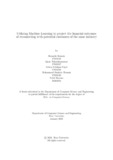Utilizing machine learning to project the nancial outcomes of reconnecting with potential customers of the same industry
Date
2021-01Publisher
Brac UniversityAuthor
Hossain, ShoumikFahmiduzzaman, Quazi
Payel, Nehrin Siddique
Hossain, Mohammad Shahriar
Hossain, Nabil
Metadata
Show full item recordAbstract
In competitive markets, it is costly to attract new customers in the business as
they already have a wide customer base; that being the case, businesses spend a
healthy budget to bring back customers who have once been with them. Despite
the business investing heavily in trying to retain their customers, the re-engagement
of the customers is not satisfactory as many businesses use intuition, experience,
and traditional methods for marketing literature. Moreover, there is a global pandemic
(COVID-19) that is hampering businesses everywhere. While the majority
of the businesses are operating on a loss, a few small businesses are already being
shut down. Thus, there is a need to increase the pro tability of the businesses
and retain their customer base. To increase customer turnover and re-engagement,
this paper focuses on the implementation of intelligent business practices using machine
learning and neural networks. The paper focuses on analyzing the customer
behavior based on their purchase behavior and transactional values for customer
retention. The classi cation is done to identify the customers who are pro table
to the business and customers who are likely to churn due to various reasons. In
this paper, we proposed a Multi-layer perceptron (MLP) to segment the customers
according to RFM methodology and customer pro tability index. The result of
MLP was compared with K-Nearest Neighbors (KNN) and Support Vector Machine
(SVM) as the later models have been widely used. Additionally, Bidirectional Long
Short-Term Memory (LSTM) models have been implemented for primary customer
classi cation and sales prediction. The prediction model is an attempt to reduce -
nancial loss on marketing campaigns for re-engagement of customers in the business.

